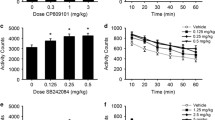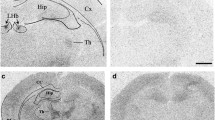Abstract
Rationale. Previous studies indicate that the D3 dopamine (DA) receptor is preferentially expressed in limbic forebrain DA terminal areas and may mediate functional effects opposite those of the D1 and D2 receptor types. However, the locations of the D3 receptors that regulate behavior, and the range of behavioral functions regulated, are not clear.
Objective. The objective of this study was to evaluate behavioral and cellular effects of the preferential D3 dopamine receptor antagonist, U99194A.
Methods. In experiment 1, the rewarding effect of U99194A (5.0, 10.0 and 20.0 mg/kg, SC) was measured in terms of its ability to lower the threshold for lateral hypothalamic self-stimulation (LHSS) in ad libitum fed rats. To amplify a possibly weak reward signal, testing was also conducted in food-restricted rats. The ability of U99194A to alter the threshold-lowering effect of d-amphetamine was also assessed. In experiment 2, effects of U99194A on horizontal and vertical motor activity were compared in ad libitum fed and food-restricted rats. In experiment 3, effects of a behaviorally active dose of U99194A (5.0 mg/kg) on brain c-fos expression were measured and compared to those produced by d-amphetamine (0.5 mg/kg, IP). In experiment 4, the motor and cellular activating effects of U99194A were challenged with the D1 dopamine receptor antagonist, SCH-23390 (0.1 mg/kg).
Results. U99194A displayed no rewarding efficacy in the LHSS paradigm. U99194A did, however, augment the rewarding effect of d-amphetamine. U99194A also produced a motor activating effect, reversible by SCH-23390, which was greater in food-restricted than ad libitum fed rats. The pattern and intensity of fos-like immunoreactivity (FLI) induced by U99194A was similar to that produced by d-amphetamine and was blocked, in caudate-putamen and nucleus accumbens, by SCH-23390.
Conclusions. These results indicate that U99194A has psychostimulant-like effects on motor activity and striatal c-fos expression that are dependent upon the D1 DA receptor. However, doses of U99194A that are adequate to stimulate motor activity and c-fos expression in striatal and limbic structures do not possess direct rewarding effects in the LHSS paradigm. Overall, these results seem consistent with the hypothesis that D3 antagonism enhances D1/D2 mediated signaling with behavioral effects dependent on both the density of D3 receptors and the prevailing level of DA transmission in particular brain regions.
Similar content being viewed by others
Author information
Authors and Affiliations
Additional information
Electronic Publication
Rights and permissions
About this article
Cite this article
Carr, K., Yamamoto, N., Omura, M. et al. Effects of the D3 dopamine receptor antagonist, U99194A, on brain stimulation and d-amphetamine reward, motor activity, and c-fos expression in ad libitum fed and food-restricted rats. Psychopharmacology 163, 76–84 (2002). https://doi.org/10.1007/s00213-002-1132-0
Received:
Accepted:
Published:
Issue Date:
DOI: https://doi.org/10.1007/s00213-002-1132-0




